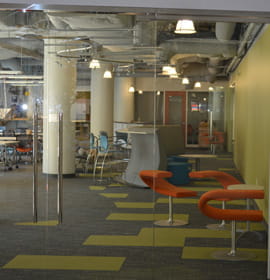ExCITe Center opening

- Drexel Environmental Collaboratory Releases Cross-Sector Findings on Severe Weather Recovery Challenges
- Student Sketches Bring Drexel’s Historic Objects to Life
- Drexel Launches the Manuel Stamatakis Center for Alternative Investments at the LeBow College of Business
- Drexel-Penn A Cappella Sing-Off Brings a New Battle of 33rd Street

Music technology, humanoid robots, app development, video games, and digital knitting machines will converge with many other technologies in one creative space when Drexel University opens its Expressive and Creative Interaction Technologies (ExCITe) Center on Nov. 28. The Center will occupy more than 11,000 square-feet of converted industrial office space at the University City Science Center’s 3401 Market Street building. ExCITe will serve as an open work area and showcase for multi-disciplinary projects and activities, aiming to combine science, technology, engineering, arts and math in an environment that encourages collaborative exploration and innovation.
Anchored by research teams from Drexel’s Antoinette Westphal College of Media Arts & Design, the College of Engineering, and the iSchool-College of Information Science and Technology, the ExCITe Center represents a step forward in the ambitious plans of Drexel and its partners in the community to develop an “Innovation Neighborhood” in University City and West Philadelphia.
“The opening of the ExCITe Center reflects Drexel’s commitment to re-imagine the urban research university for the 21st Century,” said Drexel President John A. Fry. “We seek to foster creativity, innovation, collaboration and a commitment to community. The ExCITe Center will be a place that brings all of those core values together to create real economic opportunities for our city and region as well as a significant impact in society.”
The new facility will serve as the physical hub for ExCITe activities. It will provide space for research and projects, host events and workshops and nurture the potential of the digital creative economy in the region. ExCITe will house the Shima Seiki Haute Technology Lab, a lab that allows designers, artists and engineers to use computerized knitting technology. The Shima Seiki Haute Technology Lab is supported by a donation from the U.S. subsidiary of Shima Seiki Manufacturing, Ltd. of Japan.
ExCITe will also house Drexel’s Center for Visual and Decision Informatics (CVDI), a university-industry consortium dedicated to the development of visualization technologies that will make the enormous quantity of digital data decision-actionable. There is also room for meetings, conferences and collaborative brainstorming within the versatile space, which was designed by UJMN Architects + Designers.
Research in the ExCITe Center will include all aspects of expression and interaction, from performing arts technology to civic and city-scale computing. It will also, build on Drexel’s existing collaborations with arts and cultural institutions, regional development organizations and government.
“The ExCITe Center brings together not only technologists and researchers, but also designers, artists and musicians, city and transportation planners and civic innovators and entrepreneurs,” said Dr. Youngmoo Kim, the director of the ExCITe Center. “It’s a place for creative and passionate people who want to work together to transform Philadelphia through innovation and the digital creative economy.”
The Center has coordinated seed funding for several pilot projects, including the development of a Microsoft Kinect game to help patients with cerebral palsy stay active, the creation of a virtual opera experience that places the audience in the shoes of the singers and the production of “Sonic City,” a series of stations that capture the various sounds of daily life designed to connect the city.
These projects are representative of the collaborative efforts that the center aims to facilitate. The Kinect project brings together faculty from the Westphal College, the School of Biomedical Engineering, Science and Healthy Systems and the College of Nursing and Health Professions. The virtual opera research unites Drexel faculty with partners from the Opera Company of Philadelphia and The Curtis Institute of Music. “Sonic City” brings together Drexel’s Colleges of Engineering, Arts & Sciences, and Media Arts & Design with the non-profit Breadboard and the geospatial software company Azavea.
The Center for Visual and Decision Informatics brings together faculty and students in Drexel’s iSchool and College of Engineering with engineers and scientists in Children’s Hospital of Philadelphia, Johnson & Johnson and Sungard Availability Services, among others.
In This Article
Contact
Drexel News is produced by
University Marketing and Communications.